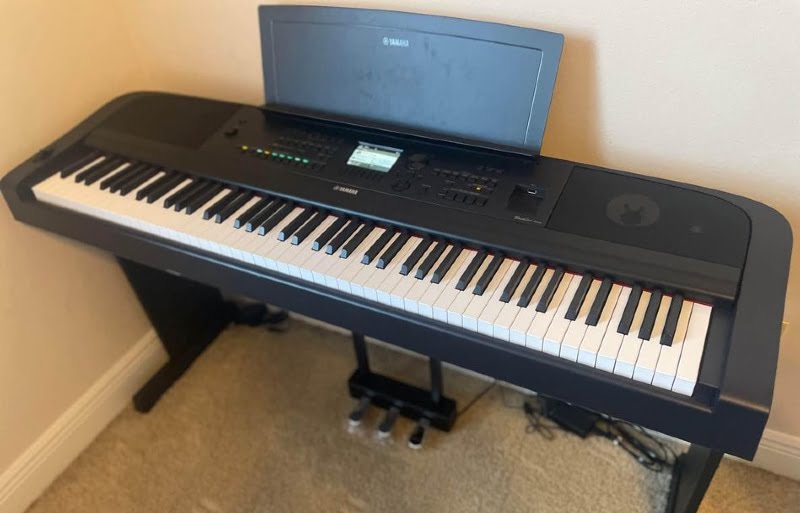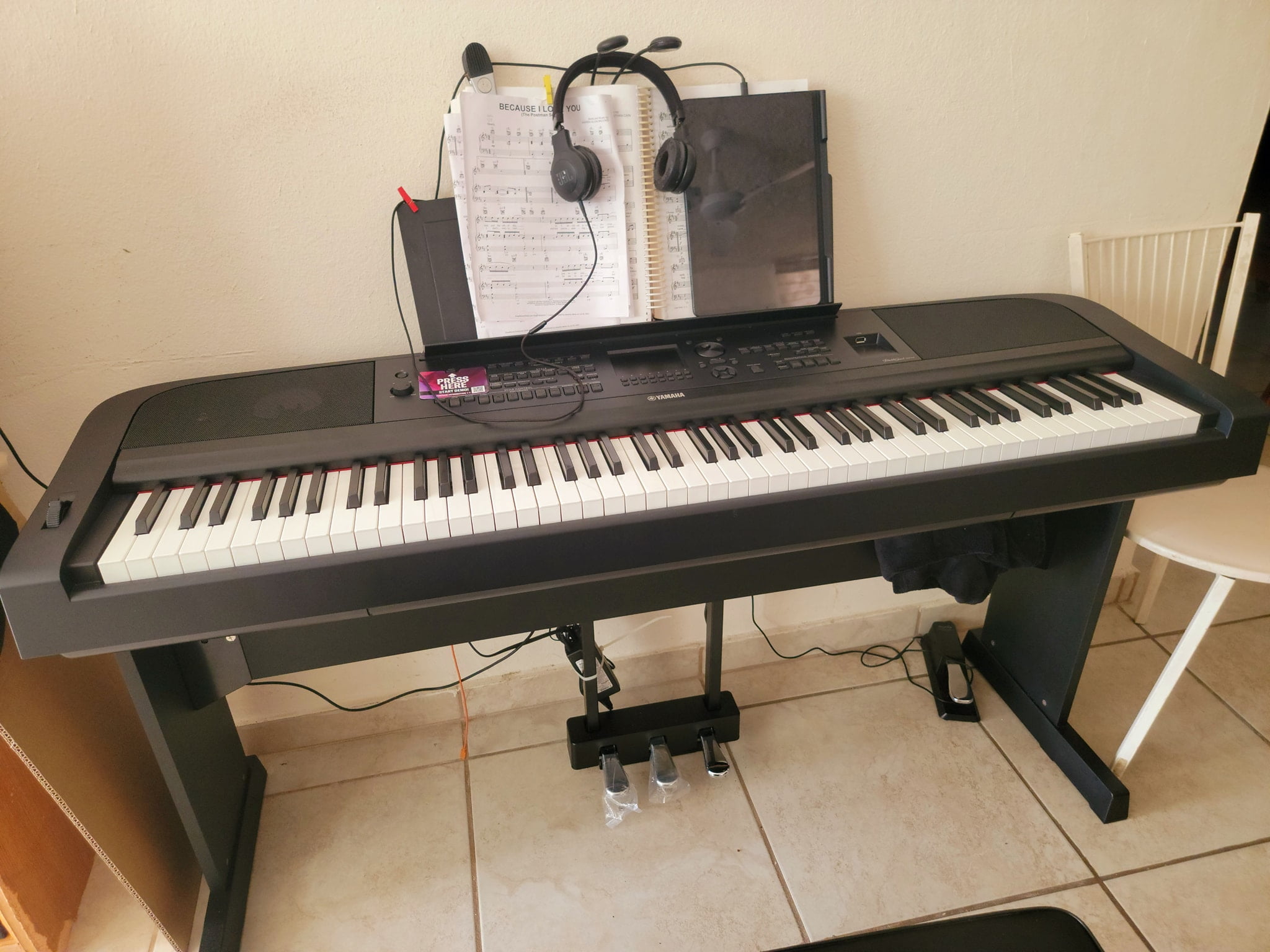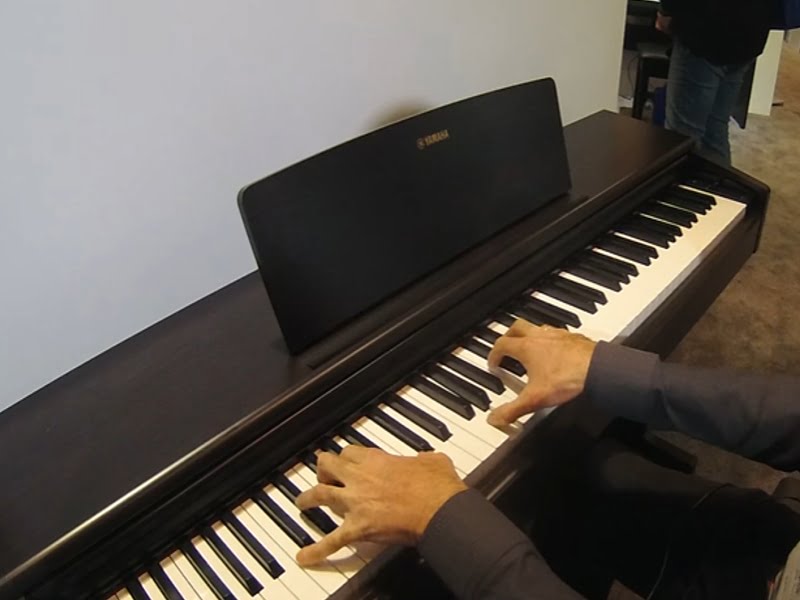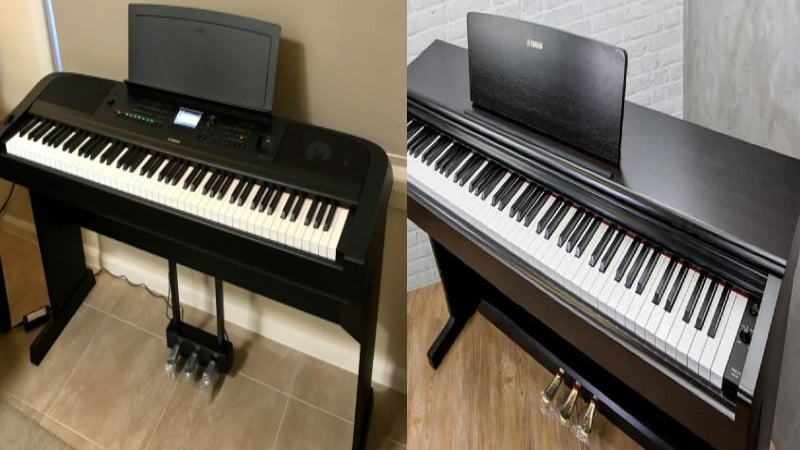Finding a digital piano is hard, but this Yamaha DGX-670 vs YDP 144 comparison is a great way for you to narrow down your options.
There are many digital pianos available nowadays. And two particular models that caught my eye were the Yamaha DGX-670 and the YDP-144. At first glance, it’s easy to assume that the YDP-144 wins out since it’s the more expensive model.
But as you’ll see in this Yamaha DGX-670 vs YDP-144 comparison, that isn’t the case.
When testing these two models, I found the Yamaha YDP-144 to be worth its price. However, the Yamaha DGX-670 was significantly more flexible and versatile. And at the end, this made it the better pick for most pianists.
In this comparison, I’ll dive into the details of both pianos. That way, you can easily figure out which one is the better fit for your needs!
Yamaha DGX-670 vs YDP 144: Comparison Chart




Last update on 2025-04-14 / Affiliate links / Images from Amazon Product Advertising API
Yamaha DGX-670 vs YDP 144: A Head-to-Head Comparison
Whenever I compare two digital pianos, I always look at three comparison points: feel, tone, and piano features. These are the most important aspects of any digital piano and are the things you should pay the closest attention to. And in this comparison, The Yamaha DGX-670 won with a score of 3-1. While these two pianos share many features, the Yamaha DGX-670 is much more flexible, which is why it ended up winning this comparison.
Feel
The winner: Yamaha DGX-670

While these pianos share the same hammer action system, the Yamaha DGX-670 has a slight texture on the keys, which makes a subtle but important difference. So, both pianos can offer you realistic weight and resistance when playing, but the Yamaha DGX-670 does a much better job of replicating the texture of a real acoustic piano.
+Hammer Action
Before we dive into the key texture, I want to talk about the hammer action system. Both pianos utilize Yamaha’s Graded Hammer Standard. This is the first tier of Yamaha’s graded hammer action systems, but it performs much better than many other options in the price range.
This is because the system is designed to replicate the small weight differences that you get with an acoustic piano. This is much more realistic than many other weighted keyboards in this price range, which is why I loved seeing this feature.
That said, since the Yamaha YDP-144 is more expensive, it would have been more fitting to see the GH3, which makes the keys bounce back a bit faster, like a high-quality acoustic piano.
I loved the piano action systems on both pianos. However, I was greatly disappointed by the key texture on the Yamaha YDP-144. While I didn’t expect fully textured keys, seeing glossy plastic keys on this piano was a huge disappointment.
While the DGX-670 also features plastic keys, at least the black keys have a satin finish, which provides some sort of textural difference.
So, while it was a fairly close battle, the Yamaha DGX-670 eventually edged out the win due to its slightly more realistic key texture.
Tone
The winner: Yamaha DGX-670
If you’re looking for high-quality and realistic piano tones, both instruments will serve you well. Since they utilize the same tone generator, they provide the same tonal quality. However, keep in mind that the Yamaha DGX-670 comes with many more tones, which is why it won when comparing this specific feature.
+Tone Generator
At this price range, it doesn’t get much better than the Yamaha CFX tone generator. While this tone engine still utilizes samples, they are some of the best-quality recordings coming from Yamaha CF grand pianos. This is why the piano tones from both instruments are some of the most realistic I’ve heard in this price range.

+Sound Library
The reason the Yamaha DGX-670 came out on top in this comparison was the sound library. Since the YDP-144 is solely a portable digital piano, it doesn’t come with a wide range of piano tones. In fact, this instrument only comes with 10 voices. And even if these are the essential voices that any pianist would find useful, it’s far from varied.
On the flip side, the Yamaha DGX-670 features over 600 different voices. Of course, this means that it has all the essentials like piano, electric piano, organ, strings, and bass while also featuring unique sound effects, drum kits, and synthesizers.
But while I loved the variety on the Yamaha DGX-670, some of the tones weren’t the best quality. This is because not all of the tones come from the CFX sound engine. But when you compare this tone library to the one on the YDP-144, the DGX-670 is the clear winner.
Piano Features
The winner: Tie
The last comparison point between these two was the piano features. And in this category, I couldn’t choose a winner. This is because both pianos come with a similar maximum polyphony and set of effects. So, this is how the YDP-144 managed to edge out one point in this comparison.
+Polyphony
Let’s start by admitting that the Yamaha DGX-670 has a higher polyphony than the YDP-144. The YDP-144 only has 192-note polyphony, while the DGX-670 has 256-note polyphony. And while you can theoretically do a bit more with the Yamaha DGX-670, the difference is very minimal.
Polyphony refers to the piano’s ability to play multiple notes at the same time. So, the Yamaha DGX-670 and the YDP-144 can play 256 and 192 simultaneous notes, respectively. This is great as you can be very expressive and add emotion to your playing through the sustain pedal and various playing modes without affecting the tonal quality.
+Effects
These pianos come with their own effects sets. The DGX-670 features Reverb, Chorus, DSP, IAC, and Part EQ, while the YDP-144 comes with Reverb (4 types), IAC, Stereophonic Optimizer, and String and Damper Resonance. So, each piano has its own advantages when it comes to the effects you have.
The effects on the DGX-670 are geared more towards pianists playing various musical styles. Since this is an arranger piano, you need this versatility. The YDP-144, on the other hand, features effects that would be great for traditional pianists looking to emulate teh character of an acoustic piano.
So, at the end, the best effects set for you largely depend on your playing style. This is why it’s important to choose digital pianos based on the way you play piano and make sure it has all the features you need for your playing.

Yamaha DGX-670 vs YDP 144: The Similarities
These pianos come from the same brand, so you can expect a few similarities. To start, they feature the same hammer action system. While it would have been nice to see a more premium setup on the more expensive YDP-144, the GHS system is perfectly fine.
On top of that, these pianos both use the CFX sound engine for their piano tones. This is why the pianos have very bright and realistic piano sounds that are very similar to the ones you might hear on Yamaha CF Grand Pianos.
That said, these pianos are definitely designed for different users. The DGX-670 is the more flexible option. So, I would choose this if you want to play many musical genres and you want to experiment with different sounds.
But if you’re fine with the essential digital piano tones and play a more traditional style of music, the YDP-144 might actually fit your needs better.
Quick Rundown of the Yamaha DGX-670
- CFX Stereo Sampling faithfully reproduces the sound of Yamaha's flagship CFX Full Concert Grand.
- GHS weighted action is heavier in the low keys and lighter in the high keys, just like an acoustic piano. The special matte black key tops are designed to absorb moisture and remain tactile after extended use without becoming slippery.
- Adaptive Style automatically shifts between the Main Style Variations by changing your velocity and number of notes played.
- Unison and Accent function adds a doubled voice to your melody line and musical "hits" when you accent your notes.
- Smart Chord lets you play great-sounding chords from simple Pop triads to complex jazz 7th chords with just a few fingers.
Last update on 2025-04-14 / Affiliate links / Images from Amazon Product Advertising API
Quick Rundown of the Yamaha YDP 144
- Your purchase includes One Yamaha Arius Series, YDP144 model | Bench, 50 Classical Music Masterpieces Book, Owner’s manual & Quick Operation Guide
- Piano dimensions – 53-7/16” W x 32-1/16” H x 16-5/8” | Weight – 83 lbs. | Number of pedals – 3 | Max polyphony – 192 | Number of voices – 10 | Headphones – (2) Standard Stereo phone jack | With Recording and Playback capabilities
- GHS weighted action is heavier in the low keys and lighter in the high keys, just like an acoustic piano
- Half-damper pedal control allows for continuously increasing amounts of sustain as the pedal is depressed
- The CFX Premium Grand Piano Voice recreates the power and tone of the flagship CFX concert grand piano from Yamaha
Last update on 2025-04-14 / Affiliate links / Images from Amazon Product Advertising API
Product Video
Related Articles to Yamaha Dgx 670
- Yamaha DGX 670 vs Casio PX S3000: Which Piano Comes Out on Top?
- Yamaha DGX 670 vs Roland FP 60x: Which Piano Comes Out on Top?
- Yamaha P125 vs DGX 670: Which Piano Comes Out on Top?
- Yamaha DGX 670 Vs P515: Which Gives You Bang For Your Buck?
- Yamaha DGX 670 Vs 660: The Distinct Difference In Details You Need To Know About
- Yamaha DGX 670 Vs Roland FP 30x: Which Works Better For Your Needs?
Related Articles to Yamaha Ydp 144
- Yamaha YDP144 vs YDP-144R: What’s the Difference?
- Yamaha YDP-144 vs YDP-S54: What’s the Difference?
- Yamaha YDP-144 vs 184: Which Is the Best Arius Model for the Money?
- Yamaha YDP-144 vs YDP-181: Is the YDP-144 a Worthy Upgrade?
- Yamaha YDP-144 vs Roland F-140R: Which Digital Piano Do You Need?
- Yamaha YDP-144 vs Kawai KDP-120: Which Piano Is the Best?
- Yamaha YDP-144 vs Kawai KDP-110: Why the YDP-144 Is the Better Piano
- Yamaha YDP-144 vs 164: Which Is the Better Arius Piano?
- Yamaha DGX-660 vs YDP-144: Which Is the Better Yamaha Piano?
- Yamaha YDP144 vs 163: Which Is The Best Arius?
- Yamaha YDP144 vs S34: Which Suits Your Style Better?
- Yamaha YDP-143 Vs 144: Is The YDP-144 A Worthy Upgrade?
- Yamaha YDP-103 Vs 144: A Battle Of Two Arius Models
- Casio PX-870 Vs Yamaha YDP-144: Which Is The Better Console Digital Piano?
- Casio PX-770 vs Yamaha YDP-144: Which Is The Better Digital Piano?
References:
- Yamaha DGX-670: https://www.sweetwater.com/store/detail/DGX670BK–yamaha-dgx670b-88-key-black-portable-grand-includes-pa150-power-adapter-and-sustain-pedal-black
- Yamaha YDP 144: https://usa.yamaha.com/products/musical_instruments/pianos/arius/ydp-144/specs.html#product-tabs
Lulacruza is an electronic folk duo operating at the junction of the hypermodern and the ancient. Our music weaves together hypnotic female singing, South American folk instruments and electronic processing, while channeling pulsating waves from the source of creation.
Lalucruza is also a community where you can connect with other music lovers to collaborate, exchange ideas and share knowledge. A platform for who wants to learns the basics of playing piano, guitar, drum masters’ technique, etc.. is the premise of our website.
